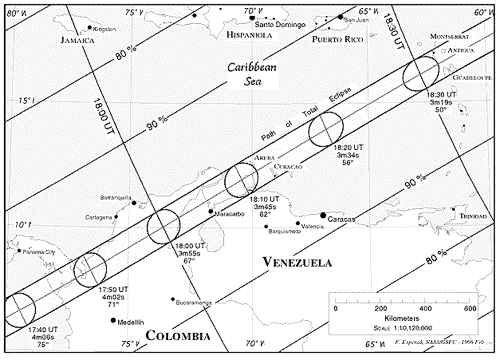|
Total solar eclipses are very rarely observed. That's not to say that they don't occur often--they do. Because the cone-shaped umbra's tiny tip barely brushes the surface of the earth, each eclipse only covers a very small area. Add to this that 71 percent of the earth's surface is covered with water, and you realize that a very tiny portion of the earth's population ever experiences a total eclipse. Either you have to by coincidence be in the right place at the right time, or you must be willing to travel great distances to be at the right place at the right time. I fall into the second category. So far I've been lucky enough to see three eclipses (out of three attempts!). To view them I have found myself in the middle of Canada's Lake Winnipeg in midwinter, in equatorial Africa in Kenya, and at the southernmost tip of Baja California. As you can see, chasing eclipses is a great excuse to travel! You'll always end up somewhere interesting. Every eclipse traces out a long path as the shadow moves across the surface of the earth. Below is a view of the upcoming eclipse in February.  As you can see, the two central parallel lines that make up the path of the umbra cover quite a distance. The much wider area shows the path of the larger penumbra, where a partial eclipse can be seen. Let's follow along this path and put in some closer maps as we approach Aruba--our outpost for this eclipse. The shadow first touches down near the equator out in the Pacific Ocean. It travels eastward and first hits land at the Galapagos Islands, where it brushes past the northenmost of those famous islands. Continental landfall occurs in Panama and Colombia, where the eclipse passes over the cities of Montería, Sincelejo, Magangué, Valledupar, and Maracaibo.
The path nicks northern Venezuela and then heads out into the Carribean, where it will pass over the islands of Aruba, Curaçao, Montserrat, Antigua, and Guadeloupe. Here's a closer view of northern Venezuela, Aruba, and Curaçao. 
|
 Go Back |
|
Where Do You See an Eclipse |
|
|||||||||
|
This resource is presented by The Exploratorium and NASA's Sun-Earth Connection Education Forum. |
The Exploratorium 1998 |
